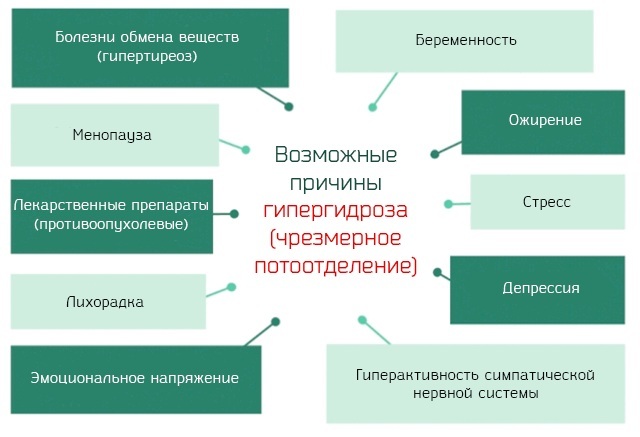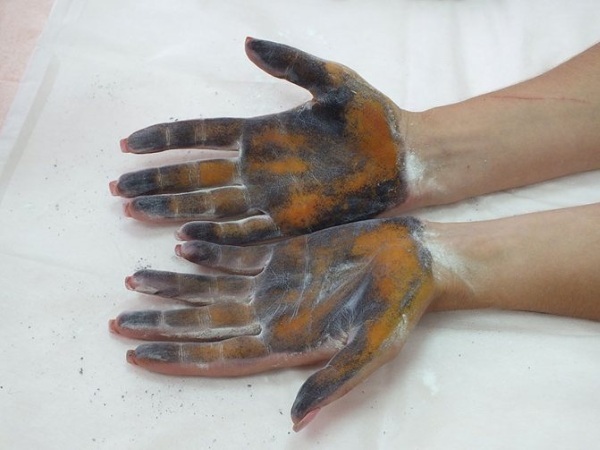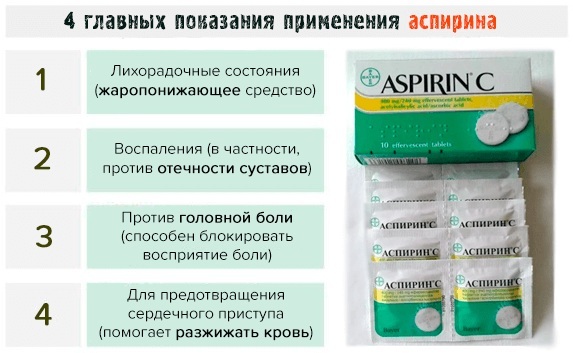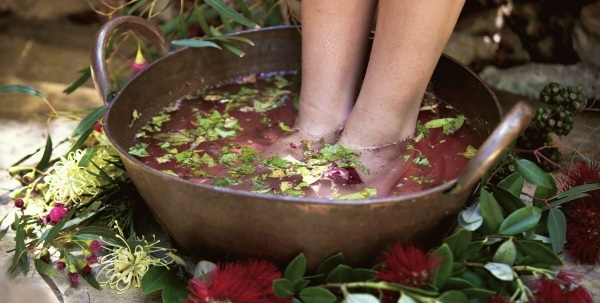If sweat feet and palms of a person, then the reasons may be associated with malfunctions of the endocrine system, with pathogenic microorganisms parasitizing on skin, with a violation of fluid metabolism, with nervous tension, as well as the influence of external factors (temperature, humidity air).
Record content:
-
1 Possible reasons
- 1.1 In a baby
- 1.2 A child over 3 years old
- 1.3 In adolescents
- 1.4 In adults
- 2 Diagnostics
-
3 Treatment methods
- 3.1 Means for external use
- 3.2 Medications
- 3.3 Folk remedies
- 4 Possible consequences and complications
- 5 Video about hyperhidrosis of the hands and feet
Possible reasons
The feet and palms sweat (the reason for this condition can be pathological) sometimes due to congenital anomalies and individual characteristics of the body. Moreover, they are all different depending on the age of the person.
In a baby
Sweaty feet and palms (the reason in infants is justified by a violation of fluid metabolism due to unstable water metabolism at this age) due to the following factors:
- increased acidity of the blood;
- high humidity or too dry indoor air;
- disease of an infectious nature;
- sluggish inflammatory process;
- thick blood;
- dysbiosis (regardless of degree);
- fatty mother's milk (abdominal cramps, bloating, pain, sweating, as a defensive reaction of the body, periodic facial flushing is possible);
- increased concentration of histamine, basophils in the blood;
- porosity of the skin, thin dermis.
Sweating of the palms and feet of a baby, as a rule, disappears after his transfer to baby food. The child's body receives more nutrients, in particular polysaccharides, which secrete more energy during their splitting, there is a stabilization of metabolism, including fluid metabolism.
In a healthy child, sweating appears only when overheating, for example, it can be diligently wetting the chest or bottles, moodiness or nervousness, in which the baby performs a lot of movements, attempts to sit down or roll over.
In a healthy body, these processes are not terrible, since excess fluid is always excreted from the body along with urine. Most often, the back and inguinal cavities sweat.
A child over 3 years old
The main reason in children is inadequate nutrition, also, starting from the age of 3, an awareness of fear comes to the baby, which is also a provoking factor. With a feeling of fear, an excess amount of adrenaline enters the bloodstream, blood circulation accelerates, and capillary permeability increases (this applies to any nervous overstrain).
In children, the capillaries are much more porous than in adults, the blood is thinner. In families with an unstable emotional environment, children have a very high risk of sweating.
Feet often sweat due to unusually long standing. When this position is taken, fluid flows into the lower extremities, the load on the valves of the blood vessels increases, and excess fluid is released through the feet. This condition is normal for active babies.
Hyperhidrosis in children is rarely an independent disease. This condition, in most cases, passes after hormonal changes in the body.
From 6 to 12 years old:
- lack of earth metals, B vitamins;
- frequent colds;
- intoxication of the body due to the vital activity of helminths.
Another possible cause of foot sweating is wearing tight or synthetic shoes. Therefore, when choosing shoes, you should pay attention not only to the material, but also to the possibility of air exchange. Until the hormonal background is normalized, the child's legs should in no case be worn out.
To do this, you need to adhere to the following rules:
- do not buy tight shoes or shoes for growth;
- prevent the feet from overcooling, in these cases microcracks appear on the delicate children's skin, and pathogenic microorganisms, falling into these cracks, provoke an inflammatory process, mycosis;
- if shoes are made of synthetic materials, then tights or socks should be made of material without impurities of synthetics.
In adolescents
The feet and palms of adolescents sweat, as a rule, due to hormonal changes in the body during puberty.
Factors:
- adaptation of the body to prostaglandin (mainly in men when reaching the optimal mode of the prostate gland functionality);

- production of more estrogen in relation to body weight and metabolic rate (in women);
- temporary hyperthyroidism during the restructuring of the thyroid gland;
- lack or excess of dopamine, serotonin according to the metabolic rate.
In adolescents, palms can sweat on nerves if there is a predisposition to vasoconstriction. If there is a lack of fluid, the release of adrenaline does not provoke sweating.
Many adolescents have a habit of keeping their palms bent for a long time. In this case, condensation accumulates. Not to be confused with sweating.
Hygiene products for the care of feet and palms can also cause sweating, like an allergic reaction or irritation of the dermis. The peculiarity of such perspiration is that sweat of different consistency and smell in one area.
With an eating disorder, the palms and feet are covered with profuse liquid sweat at the moment of feeling the longed-for smell of food and a self-perceived ban on its use.
Hyperhidrosis is accompanied by slight tingling of the fingertips and numbness of the feet. Sweating due to RPD is mainly seen in anorexia and bulimia. In adolescents, the condition, in most cases, passes after the normalization of the hormonal background.
In adults
The feet and palms sweat (the cause in adults is often associated with chronic diseases), in contrast to childhood and adolescence, sometimes constantly.
Factors:
- hyperhidrosis as an independent disease;

Causes of hyperhidrosis - when the feet and palms sweat - mycoses;
- periodic stress combined with calcium deficiency;
- periodic or accompanied by high fever colds (sweating manifests itself when the temperature drops);
- liver disease that disrupt fat metabolism;
- depletion of the body;
- completion of the course of taking medications that provoke puffiness (glucocorticosteroids, non-steroidal anti-inflammatory, saline laxatives);
- deposition of salts in the joints;
- reactive inflammatory processes;
- intestinal diseases that provoked putrefactive processes;
- heart and kidney failure;
- chronic course of immune and autoimmune diseases;
- the course of neuralgia, regardless of etiology;
- swelling of the lining of the brain;
- ketonuria;
- dysbiosis of 2 and 4 degrees;
- transudative pleurisy;
- tuberculosis, regardless of form;
- systematic use of alcohol;
- inflammation of sweat or sebaceous glands;
- diabetes mellitus (it is extremely rare in children, not often in adolescents).
In a healthy person, nervous overstrain does not affect metabolic processes sufficiently for the occurrence of sweating of the palms and feet. If sweating is the result of anxiety, this is a mild CNS pathology.
Diagnostics
The main diagnostic method is the iodine starch test. An iodine solution is applied to the sweating area and allowed to dry, then starch is applied. The more intense the sweating, the more the treated area darkens.
The method allows you to determine the area of sweating for antiperspirant treatment, but does not determine the cause of hyperhidrosis. Iodine starch paper does not provide high accuracy in determining the boundaries of pathology, since it is sensitive to changes in the acidity of the skin.
Other diagnostic methods:
- a general blood test allows you to determine the presence or absence of an allergic reaction (basophils), helminthiasis (eosinophils), sugar level, the course of the inflammatory process (SOE, leukocytes);
- a detailed biochemical blood test (thyroid-stimulating hormones, T-lymphocytes, nutrient balance, prostaglandins);
- Ultrasound of the thyroid gland (size, density);
- fluorography (volume and segmental density of the lungs).
If mycosis is suspected, the epidermis is taken from the feet and palms.
The price depends on the cost of reagents, the complexity of decoding the results, the need to provide additional conditions for the growth of pathogenic cultures.
| Method name | Average price, rub. |
| Iodine starch test | 300 |
| General blood analysis | 470 |
| Thyroid stimulating hormone test | 560 |
| Detailed biochemical blood test | 750 |
| Ultrasound of the thyroid gland | 800 |
| Skin scraping for mycoses | 500-650 (depending on the pathogen) |
The table shows the prices of private laboratories, in the district clinic prices are 2-5 times lower. But, not every polyclinic conducts a detailed biochemical blood test and an analysis for mycoses. The results of laboratory analyzes are valid in any medical institution on the territory of the Russian Federation, and the regional polyclinic - only in this institution.
The most effective method is a detailed biochemical blood test. To draw up a complete clinical picture, it must be repeated after 3 days. Ultrasound of the thyroid gland is performed in case of deviations from the norm of thyroid-stimulating hormones T2-T4.
Treatment methods
The tactics and duration of the course of treatment depends on the results of the diagnosis. The main goal of therapy is to eliminate the root cause and relieve symptoms. At an early stage of hyperhidrosis, medications are prescribed symptomatically. Correction of fluid metabolism is carried out with a balanced diet, powders, deodorants, ointments, creams.
Sweating of the palms and feet is eliminated with the help of external agents, medications, and traditional medicine.
Means for external use
These funds include:
- antiperspirants;
- powder;
- antiseptics;
- antifungal agents.
Antiperspirants are classified into:
- therapeutic (eliminating the cause of sweating, if it refers to diseases or pathologies of the skin);
- refreshing (temporarily eliminate odor, block sweat glands).

The effect of refreshing antiperspirants lasts 12 hours on average.
It is not recommended to buy medical powders on your own. They are divided into 2 groups: for the selection of excess fluid and for its preservation. If the skin suffers from a lack of vitamins A, C, then none of the types will work. Nourishing creams with these vitamins are needed. Excessive use of talcum powder can dry out the skin, which will aggravate sweating.
Large cracks will appear, which will begin to rot or the skin will be saved from drying out by releasing additional moisture through the enlarged pores. The average duration of a course of medicinal antiperspirants is 6 months, but doctors suggest that such therapy be symptomatic.
Antiseptics are used both for therapeutic and prophylactic purposes to minimize the effects of pathogenic microorganisms that have not managed to penetrate deep into the dermis. Overuse of antiseptics can lead to dry skin with further exfoliation.
Antifungal agents for external use remove sweating only in the presence of mycosis. They are used in combination with antifungal medications. The most common: Diflucan, Terbinox, Terbinafine, Exoderil.
Medications
Drugs in tablet form for sweating do not cure the underlying disease. The main task of these drugs is to normalize fluid metabolism, which, without a balanced diet, is disrupted 1-3 months after the termination of the course of treatment.
The most common medications for hyperhidrosis:
- Active dry - 1 scoop 2 times a day for 30 minutes. before meals;
- aspirin - symptomatically from the age of 18;

- valerian - 1 tab. 2 times a day no more than 5 days, take only if you feel anxiety, insomnia.
Do not take the above products on an empty stomach. To avoid counterfeiting, purchase drugs only in authorized drugstore chains. The dosage and course of medication is prescribed only by a doctor.
For example, domestically produced valerian tablets are sold as drugs to slow the heart rate. But the Bulgarian manufacturers are a component of complex therapy for the treatment of mental illnesses and disorders.
Other diseases that can trigger sweating:
- neuralgia (prescribed for treatment: No-shpa (symptomatically), Nimid (1 tab. 3 times a day no more than 5 days));
- dysbiosis of 2 and 4 degrees (antibiotics of the fluoroquinolone class are prescribed in 2 tables. with an interval of 12 hours. no longer than 7 days);
- immune diseases of a rheumatoid nature (a course of taking glucocorticosteroids is carried out, the intensity and the duration of which is determined by the doctor, after the completion of the course, sweating may increase in duration 5-7 days).
The feet and palms sweat (the reason may be the abnormal location of the sweat glands), sometimes due to diseases. The doctor may prescribe Botox as the primary therapy. Treatment consists of a course of subcutaneous injections of botulinum toxin-based drugs.
Flaws:
- many contraindications and side effects;
- botulism bacteria block nerve endings, which can lead to necrosis;
- some time after the procedure, there is pain.
The break between courses is at least 6 months. The procedure is resorted to if the benefits outweigh the possible harm.
Folk remedies
Folk remedies are effective for skin diseases. If the cause is a disease of the internal organs or the endocrine system, they only alleviate the symptoms.
| Recipe composition | Preparation | Application |
| A decoction for a bath with hyperhidrosis | ||
|
1. Boil water in a clean container. Cool down. 2. Add caraway seeds and boil on the stove. Boil for 30-40 seconds. 3. Add mint. Boil for another 20-30 seconds and turn off. 4. Insist for 3 hours at room temperature. (Do not filter, do not heat). |
Take a bath for 10 minutes. Allow to dry naturally. Wash hands and feet with warm water. Wipe dry with gentle movements. Also, the broth helps with dysbiosis and nausea, regardless of their cause. Do not give to children with helminthiasis, as asphyxia is possible. The duration of therapy is 7-10 days. |
| Ointment for sweating | ||
|
1. Melt the fat in a water bath and add the rest of the ingredients to it. 2. Close the container with a lid and remove from heat. 3. Wrap with a towel. Leave to cool completely. 4. Then reheat in a water bath until warm. Strain. |
Use once a day for no more than a week, rubbing into problem areas. Store in a cool place. If the cause of sweating is herpes stomatitis, use for lubrication 2 times a day for 3 days in a row. |
| Decoction for the foot bath | ||
|
1. Boil water and add needles. 2. Boil for 15 minutes. over very low heat. 3. Lightly dip the peels of the lemons. 4. Boil for about a minute, then turn off. 5. Add onion skins and cover. Wrap up. 6. Insist for 24 hours, then heat and strain. |
Wash your feet well before the procedure. Take the bath until the broth begins to cool. Helps with any fungal diseases of the feet. |

For medicinal mixtures, it is advisable to freeze herbs in small portions. If you are allergic to citrus fruits, they should be replaced with rose hips.
With inflammation of the sebaceous glands, you can also use this recipe. Instead of soap, wash your hands with a thin lemon ring 1-2 times a week. Then gently pat dry with a towel.
Allow to dry naturally, and then lubricate with baby cream or petroleum jelly. It should be remembered that the greasy product should not remain on the hands. If a cream or petroleum jelly is applied in a thick layer, the pores become clogged. The method cannot be used for burns, cracks. The products are always applied to a clean surface.
Possible consequences and complications
Sweating feet and palms can lead to the following complications:
- premature aging of the skin;
- aggravation of the inflammatory process with a subsequent decrease in general immunity;
- increased skin permeability, which increases the likelihood of an infectious disease of a viral or bacterial nature;
- chronic sweating inhibits the synthesis of the natural pigment melanin, which eventually leads to vitiligo (white age spots);
- a prerequisite for allergic manifestations due to increased sensitivity of the dermis;
- inflammation of sweat and sebaceous glands with a high risk of lymphadenitis, cancer of the glands or skin.
There are two main groups of reasons why the feet and palms sweat - this is a physiological feature of the body and the development of any pathological processes.
That is why it is not worth starting self-medication, especially if the problem shows itself very clearly, as this can lead to unpleasant consequences (exfoliation of the epidermis, allergic manifestations on the skin in the form of redness, scabies, pigmentation, the appearance of small pimples and other).
The first step is to see your doctor to determine the root cause. The results of the examination will be the basis for the doctor to prescribe adequate therapy, based on the ratio of benefits and harms to the body.
Video about hyperhidrosis of the hands and feet
Why hands sweat and how to overcome hyperhidrosis:



